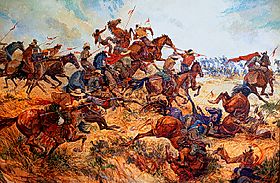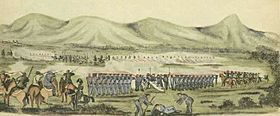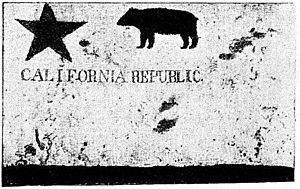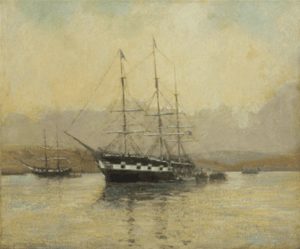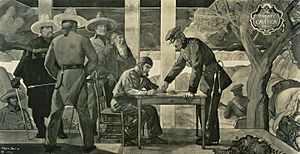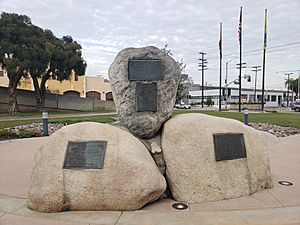Conquest of California facts for kids
Quick facts for kids Conquest of California |
|||||||
|---|---|---|---|---|---|---|---|
| Part of Mexican–American War | |||||||
|
Top: Battle of San Pasqual; Bottom: Battle of Santa Clara
|
|||||||
|
|||||||
| Belligerents | |||||||
| Commanders and leaders | |||||||
| Mariano Guadalupe Vallejo Andrés Pico Juan Bautista Alvarado |
John C. Frémont Robert F. Stockton Stephen W. Kearny |
||||||
The Conquest of California was a key part of the Mexican–American War. It happened in Alta California, which is now the state of California. The United States fought against Mexico to take control of this land. The conflict lasted from 1846 to 1847. It ended when leaders from both sides signed the Treaty of Cahuenga.
Contents
Why Did the Conflict Happen?
War between the United States and Mexico officially began on May 13, 1846. However, it took about three months for this news to reach California. U.S. Consul Thomas O. Larkin in Monterey tried to prevent fighting. He was worried about the growing tension.
Meanwhile, U.S. Army Captain John C. Frémont was on a survey trip. He had about 60 armed men with him. In May 1846, Frémont learned that war was likely.
What Was the Bear Flag Revolt?
On June 14, 1846, a group of about 30 American settlers started the Bear Flag Revolt. They were worried about being forced to leave Mexico. These rebels took over a small Mexican army post in Sonoma. They created the "Bear Flag" and raised it.
A few days later, Captain Frémont and his troops arrived. They supported the rebels. No real government was formed, but the Bear Flag Revolt became a famous part of California's history. Today, the California state flag looks like this original Bear Flag. It still says "California Republic."
Taking Control of Northern California
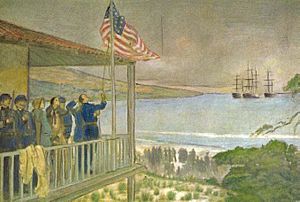
Before the war, the U.S. Navy sent many ships to the Pacific. It took a long time to sail from the East Coast to the Pacific. So, these ships had to be sent early. Their orders were to capture California ports if war broke out.
Commodore John Drake Sloat led the Pacific Squadron. When he heard about the war and the Bear Flag Revolt, he acted. His ships were already in Monterey harbor. On July 7, 1846, they captured Monterey, the capital of Alta California. No shots were fired in this "Battle of Monterey."
Two days later, on July 9, another U.S. ship captured Yerba Buena (now San Francisco). This was also done without fighting. On July 15, Commodore Robert F. Stockton took command. He was a more aggressive leader. Stockton's forces included 400 to 650 marines and sailors. This was the largest U.S. ground force in California.
Stockton also ordered Captain Frémont to gather volunteers. Frémont got 160 men, forming the California Battalion. This group included Frémont's explorers and many Bear Flaggers.
The American forces easily took over cities and ports in northern California. Places like Monterey, San Francisco, Sonoma, and Sutter's Fort were occupied quickly. Most of these takeovers happened without any fighting.
Battles in Southern California
Who Were the Californios?
Before the U.S. arrived, about 8,000 Spanish and Mexican people lived in Alta California. They were called Californios. Many lived near Los Angeles. Others lived on large farms called ranchos. Most of the 800 American immigrants lived in northern California. They generally supported breaking away from Mexico.
The Siege of Los Angeles
In Southern California, Mexican General José Castro and Governor Pío Pico left Los Angeles before the Americans arrived. On August 13, 1846, Stockton's forces entered Los Angeles without any resistance. It seemed the conquest was complete.
However, Stockton left only 36 soldiers in Los Angeles. This force was too small. On September 29, the Californios, led by José María Flores, fought back in the Siege of Los Angeles. They forced the small American group to retreat to the harbor.
Soon after, 200 American reinforcements were sent. But on October 8, they were defeated in the Battle of Dominguez Rancho. Four Americans were killed. In late November, General Stephen W. Kearny arrived with 100 soldiers. They had marched a long way through deserts. On December 6, they fought the Battle of San Pasqual near San Diego. Twenty-one of Kearny's soldiers were killed. This was the most American casualties in any battle during the California Campaign.
The Final American Victory
Stockton rescued Kearny's surrounded troops. With their combined force of 660 soldiers, they marched north from San Diego. On January 8, 1847, they fought the Californios in the Battle of Río San Gabriel. The next day, they fought the Battle of La Mesa.
The last main group of Californios surrendered on January 12. This marked the end of the fighting in Alta California.
What Happened After the Fighting?
The Treaty of Cahuenga
The Treaty of Cahuenga was signed on January 13, 1847. It officially ended the fighting in California. The treaty was written in English and Spanish. It was signed by American Brigadier General John C. Frémont and Californio General Andrés Pico. This agreement was later approved by Frémont's commanders.
More Troops Arrive
In July 1846, Colonel Jonathan D. Stevenson was asked to form a volunteer regiment. These soldiers were meant to go to California and stay there. They were called the 1st Regiment of New York Volunteers. They sailed from New York in September 1846. It took them many months to reach California.
By March and April 1847, these troops arrived. They took over many military duties from the Navy and the California Battalion. This helped secure American control.
In January 1847, Lieutenant William Tecumseh Sherman and about 100 regular U.S. Army soldiers also arrived in Monterey. More American forces continued to come to California.
- The Mormon Battalion
The Mormon Battalion was a group of volunteers who served from 1846 to 1847. They were members of The Church of Jesus Christ of Latter-day Saints. They made a very long march of about 1,900 miles from Iowa to San Diego. This is one of the longest military marches in U.S. history.
The Mormon Battalion arrived in San Diego on January 29, 1847. For the next five months, they trained and performed guard duties in southern California. Some members of the Mormon Battalion were helping to build a sawmill for John Sutter when gold was discovered there in January 1848. This discovery started the famous California Gold Rush.
The Treaty of Guadalupe Hidalgo
The Treaty of Guadalupe Hidalgo was signed in February 1848. This treaty officially ended the Mexican–American War. Under the terms of the treaty, Mexico gave up Alta California and other northern territories to the United States. In return, Mexico received $15,000,000. This land made up almost half of Mexico's claimed territory at the time.
Important Dates in the Conquest
| Date | Key Events in California |
| 13 May 1846 | The United States Congress declared war on Mexico. |
| 14 Jun 1846 | The Bear Flag Revolt began in Sonoma. American settlers raised the Bear Flag. |
| 07 Jul 1846 | U.S. Navy forces captured Monterey, the capital of Alta California, without a fight. |
| 09 Jul 1846 | U.S. forces captured Yerba Buena (San Francisco). The Bear Flag Republic ended. |
| 15 Jul 1846 | Commodore Robert F. Stockton took command of U.S. forces in California. |
| 13 Aug 1846 | Stockton's army entered Los Angeles without resistance. |
| 29 Sep 1846 | Californios revolted in Los Angeles, forcing the small American garrison to retreat. |
| 08 Oct 1846 | Californios defeated American reinforcements in the Battle of Dominguez Rancho. |
| 06 Dec 1846 | General Stephen W. Kearny's troops fought the Battle of San Pasqual, suffering many casualties. |
| 08 Jan 1847 | U.S. forces fought the Californios in the Battle of Rio San Gabriel. |
| 09 Jan 1847 | U.S. forces won the Battle of La Mesa. |
| 10 Jan 1847 | The U.S. army re-entered Los Angeles without resistance. |
| 13 Jan 1847 | The Treaty of Cahuenga was signed, ending fighting in California. |
| Feb 1848 | The Treaty of Guadalupe Hidalgo was signed, ending the Mexican-American War. Mexico gave California to the U.S. |
Images for kids


